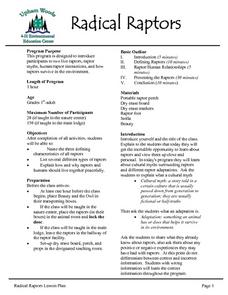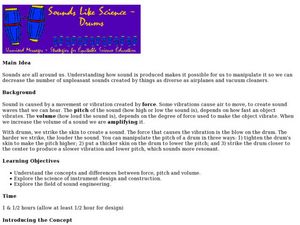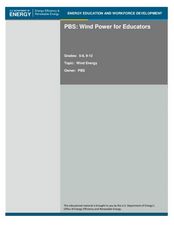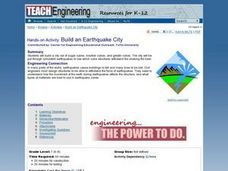Curated OER
Radical Raptors
Students are introduced to raptors and their role in the environment. They identify three characteristics of raptors and list several types of raptors found in nature. They discuss their positive and negative experiences with raptors and...
Curated OER
Paper Gliders
Sixth graders study friction and drag. In this science lesson, 6th graders use different models of gliders and test to see which of the gliders fly the farthest. Students analyze their data and construct a graph.
Curated OER
The History of Religion
Students learn about the two main types of religions. In this religion lesson, students define religion and learn about early religion as well as religion in the west. Students define animism, polytheism, pantheism,...
Curated OER
Outdoor Survival
Young scholars are introduced to basic outdoor survival concepts. They identify the seven basic needs for survival. Students describe the symptoms and treatment for frostbite and hypothermia. They compare and contrast the value of...
Curated OER
Investigating Motion
Students explore types of motion. In this motion experiment, students observe how objects move. Students work in small groups to discover the laws of motion.
Curated OER
Simple Harmonic Motion
Young scholars study harmonic motion and its oscillation. In this simple harmonic motion instructional activity students demonstrate a series of regular oscillations and explain the theory behind the experiment.
Curated OER
Forces Cause Change
Third graders will gain recognition that physical relationships affect each other and that change occurs when one object acts upon another.The teacher will recognize ways in which technology can be used to enhance the understanding of...
Curated OER
Water Pressure
Students spend time examining the concept of water pressure. In groups, they research the amount of air pressure that is felt at different levels above sea level. Using a calculator, they calculate the water pressure given different...
Curated OER
Sounds Like Science - Drums
Learners see that understanding how sound is produced makes it possible for us to manipulate it so we can decrease the number of unpleasant sounds we encounter. They make a drum to explore the concepts of force, pitch and volume.
Curated OER
Sounds Like Science: Drums
Students explore the science of sound. In this sound lesson, students craft drums from various materials and respond to questions regarding pitch, force, and volume.
Curated OER
Electrical Energy
Students conduct an experiment to find out how well different wires radiate heat when voltage is applied across the wire. They use the results of their experiments to consider how the gauge of the wire and the type of wire affect the...
Curated OER
Wind Power for Educators
Students explore wind power as a renewable resource. In this wind power lesson students build models of wind turbines and experiment with different changes to see if it increases efficiency.
Curated OER
Balancing Chemical Equations
Ninth graders explain how atoms and molecules form different substances during chemical reactions and how these processes require losing, gaining or sharing electrons. They correctly write chemical formulas and show how a balanced...
Curated OER
Simple Harmonic Motion
Students explore the theory of simple harmonic motion (SHM) by performing hands-on, practical application experiments. In this harmonic motion instructional activity, students use strings of various lengths and bobs of different weights...
Curated OER
Analysis of Lobster Claw Function. An Exercise in Biomechanics
Students observe two chelae. They write three differences they observe in their notebooks. Students suggest a hypothesis which would explain these differences. They dissect the chela. Students analyze the lobster claw as a mechanical lever.
Curated OER
Focus on Friction
The students learn about friction and forces through direct instruction and an investigation. They use measurement skills, observation skills, predicting, and drawing conclusions based on data collected during the investigation. Students...
Curated OER
Magnets 1: Magnetic Pick-ups
Students are introduced to the power of magnets. In groups, they look at different objects and make predictions on whether they believe they are magnetic or not. They test their predictions and share their results with the class.
Curated OER
Sustainable Choices
Young scholars examine energy use and the different construction materials used in their home. In this sustainable choices lesson students study different materials and what a sound environmental choice would be.
Curated OER
Muscles
In this muscles worksheet, learners describe characteristics of the three types of muscle and the function of each. Then they describe the gross and microscopic anatomy of skeletal muscle. Students also describe the steps that occur in a...
Curated OER
Bonding
In this word search worksheet, students locate 12 words related to molecular bonding. Words include molecule, ions, forces, polarity, partial, and particles.
Curated OER
Plants 1: Plant Parents
Students review their prior knowledge on plants. In groups, they compare and contrast the difference between reproducing asexually and sexually. Using the internet, they research how some plants can be forced to produce asexually.
Curated OER
Characteristics of Crystals
In this crystals worksheet, students complete a graphic organizer by filling in the characteristics of the different crystal types including melting/boiling point and electrical conductivity.
Curated OER
Build An Earthquake City
Middle schoolers work together to build an earthquake city. They simulate the shaking during an earthquake to discover if their structure is built well enough. They discover how engineers complete these types of tests to develop better...
Curated OER
Simple Machines
Third graders examine and identify the six types of simple machines. Using a model of each simple machine, they demonstrate the state the function of them to the class. They discover examples of simple machines at school and home and...























